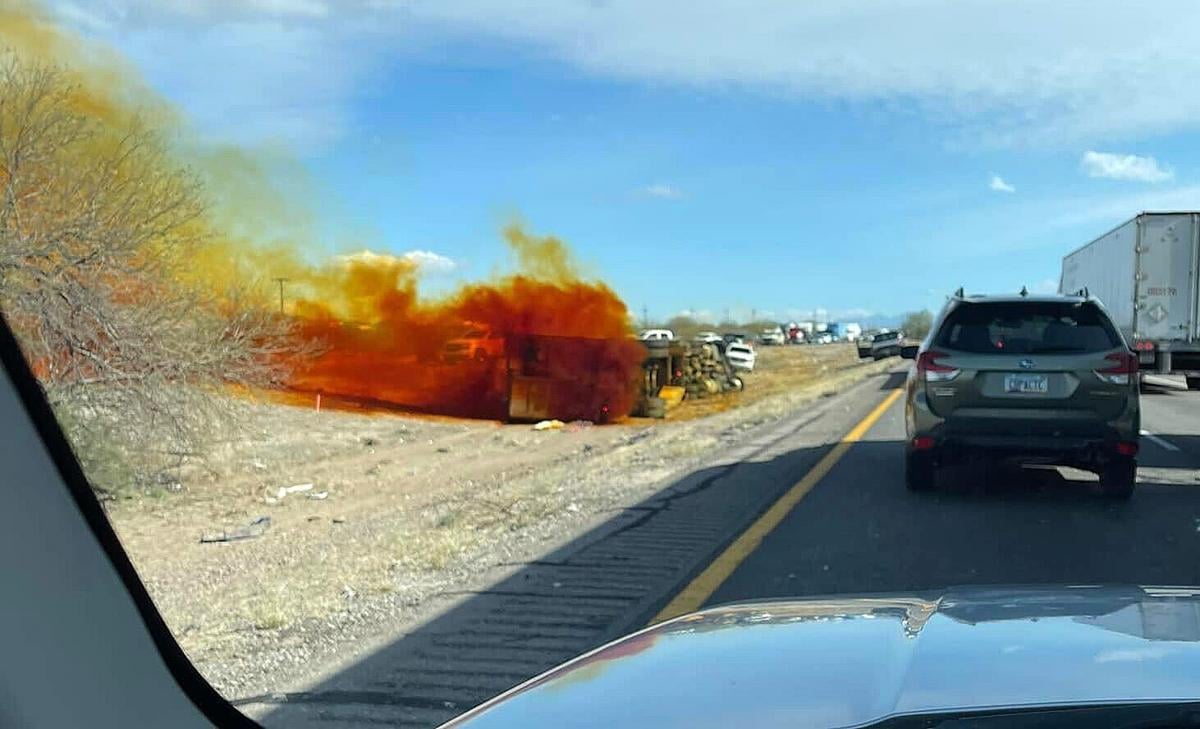Tucson hospitals and county health officials weren’t immediately notified about a nitric acid spill on Interstate 10 in February, among communication missteps in a mostly strong and effective emergency response, says a new report.
The after-action report by the Pima County Emergency Management Office, released to the public on Friday, assessed strengths and weaknesses in agencies’ response to the hazardous material spill.
On Feb. 14, truck driver Ricky Immel, 54, was driving near Kolb Road on I-10 when he slowly veered off the road and onto the median, where the uneven ground caused the truck to roll onto its left side. Containers carrying about 18,200 kilograms of nitric acid ruptured in the crash, causing the Arizona Department of Public Safety to shut down both directions of the interstate and tell residents and other people in the area to shelter in place.
Immel died in the crash. He had a blood alcohol level nearly eight times above the state’s legal limit, the county medical examiner found.
With the help of the Tucson Fire Department and DPS, the county Emergency Management Office conducted a survey and held two debriefing sessions to discuss what went well and what could have gone better. The first session was for first responders, and the second session included community stakeholders and support agencies, the report said.
“No incident response is ever perfect. Lessons are learned and reinforced,” the Emergency Management Office said in the report.
At a recent Pima County Board of Supervisors meeting, Supervisor Steve Christy asked that the report be made public and available to the board.
The report states that several agencies from various disciplines worked well together throughout the incident. Many survey participants also listed teamwork and cooperation as strengths.
The immediate response and swift actions by various agencies were also highlighted. A commuting Border Patrol agent was first at the scene and was able to take the initial steps in closing I-10 before a full closure of the interstate was ordered 15 minutes later, the report said.
Also, within 15 minutes of the initial 911 call, the substance that spilled was identified as nitric acid, and the National Weather Service was able to provide plume modeling for the first responders at the scene.
The WebEOC, a crisis information management system accessible via the Internet where responders across the state can share incident updates, was found to be a valuable source for sharing information. Using the system, updates were provided throughout the incident.
Websites made by various agencies were also praised for keeping the public informed. DPS created a website dedicated to providing updates on the crash and shelter-in-place notifications, while the Pima County Health Department worked with the Arizona Poison Control Center to create a website in response to the public’s concerns about exposure to the acid.
When it comes to opportunities for improvement, communication was brought up several times.
While the three transportation departments, the Arizona Department of Transportation, Pima County Department of Transportation and Tucson Department of Transportation, assembled traffic plans to deal with the I-10 closure, the departments did not share information with each other. This created community stress as there was no unified detour designated, the report said.
The incident command post was not clearly identified or known to all response partners, causing multiple responders to have trouble finding the DPS incident commander on-scene, the report said. One survey response said eight Marana Police Department officers were sent to the scene and could not locate the incident command post.
Radio communication between responders was another issue found. While local public safety and public service organizations can easily communicate with each other using the Pima County Wireless Integration Network, other partners who do not use it have limited access, hindering radio operability with DPS, the report said.
“Communication was hampered as interaction between the lead public information officer and other PIOs was very limited,” the report said. This led several survey takers to recommend activating a joint information system to help create unified messaging during emergencies such as the nitric acid spill.
That would help alleviate discrepancies in messaging and help provide clear information to media and public outlets, the report said.
Lastly, many responding agencies were not well informed about the incident, the report said. Initial notification about the incident was not made by DPS to the Pima County Emergency Management Office.
A recommendation has since been made that DPS notify that office of incidents affecting the community, the report said.
Other support agencies, including the Pima County Health Department, local hospitals and the Pima County Department of Transportation, were also not immediately notified of the incident, leaving many with limited information or a lack of messaging, the report said. The health department was not notified until the next day.
Exposure to nitric acid can cause irritation to the eyes, skin, and mucous membrane; it can also cause delayed pulmonary edema, pneumonitis, bronchitis, and dental erosion, the U.S. Centers for Disease Control says.
“Agencies and departments appropriately review and revise their internal policies and procedures, leading to more comprehensive preparedness for the next emergency,” the Emergency Management Office said in the report. “It is already being witnessed that lessons learned are being shared among partners, collaboration and coordination enhances community preparedness. Relationships and networking are being reinforced.”
The Arizona Department of Public Safety held a press conference Thursday to share additional information about the Feb. 14 crash on Interstate 10 that killed a man and resulted in a hazardous material spill. Video by Pascal Albright/Arizona Daily Star.





